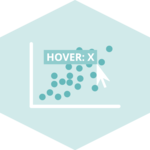React-spring for data visualization
This post is dedicated to react-spring, a javascript library for spring animations. It quickly explains what it is and how it works, and then explains how it can be used in the field of data visualization.
A minimal react-spring dataviz example. A viz component expect a position and a color prop. But it smoothly animates the transition.
What is spring animation
Spring animations are different than typical CSS easing animation. They're built on spring physics, which gives a more fluid and organic feel. The best way to be introduced to this concept is to read Josh Comeau's friendly Introduction to Spring Physics
To quote him directly:
Spring physics are like a secret ingredient; they make all animations taste betterBasic react spring animation
The best tool to build a spring animation in the react world is react-spring, a library dedicated to it. If you're not familiar with it already you probably want to take a look at their home page.
Let's start with a basic example showing how to animate a very basic viz component that just renders a circle.
A very basic animation using react and react-spring.
The useSpring funtion can take 2 types of input: an object or a function
- if object, it returns an object that has the values of our animation
- if function, it returns an array of length 2. First item is the object mentionned above. item 2 is the api that controls the spring. api is used for imperative style
Animating axes
A common hassle is to animate axes, since it's a lot of svg elements.
A very basic animation using react and react-spring.
General Knowledge
Contact
👋 Hey, I'm Yan and I'm currently working on this project!
Feedback is welcome ❤️. You can fill an issue on Github, drop me a message on Twitter, or even send me an email pasting yan.holtz.data with gmail.com. You can also subscribe to the newsletter to know when I publish more content!
Contact
👋 Hey, I'm Yan and I'm currently working on this project!
Feedback is welcome ❤️. You can fill an issue on Github, drop me a message on Twitter, or even send me an email pasting yan.holtz.data with gmail.com. You can also subscribe to the newsletter to know when I publish more content!



